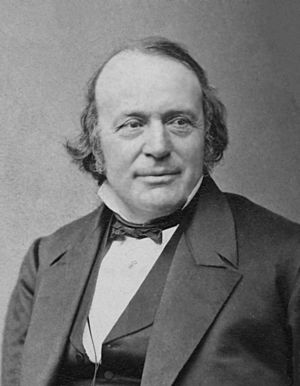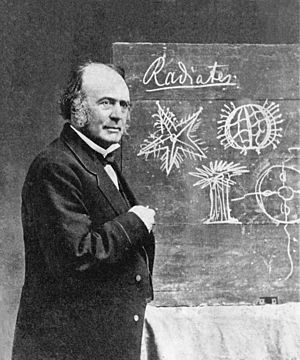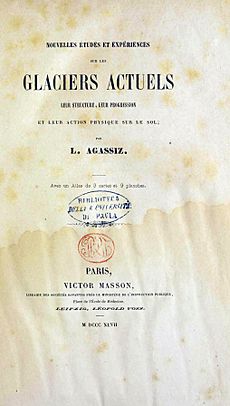Louis Agassiz facts for kids
Quick facts for kids
Louis Agassiz
|
|
|---|---|
 |
|
| Born | May 28, 1807 Môtier, Canton of Fribourg, Rhodanic Republic
|
| Died | December 14, 1873 (aged 66) |
| Citizenship | United States |
| Education | University of Erlangen-Nuremberg (PhD) University of Munich |
| Known for | Ice age, Polygenism |
| Spouse(s) | Cecilie Braun Elizabeth Cabot Cary |
| Children | 3, including Alexander and Pauline |
| Awards | Wollaston Medal (1836) |
| Scientific career | |
| Fields | |
| Institutions | University of Neuchâtel Harvard University Cornell University |
| Doctoral advisor | Carl Friedrich Philipp von Martius |
| Other academic advisors | Ignaz Döllinger, Georges Cuvier, Alexander von Humboldt |
| Notable students | William Stimpson, William Healey Dall, Carl Vogt, David Starr Jordan |
| Author abbrev. (zoology) | Agassiz, Ag., L. Ag., Agass. |
| Signature | |
 |
|
Jean Louis Rodolphe Agassiz (born May 28, 1807 – died December 14, 1873) was a famous scientist. He was born in Switzerland and later moved to the United States. He was a biologist and geologist who studied Earth's natural history.
Agassiz is known for his detailed observations and scientific work. He wrote many books and made important contributions to zoology (the study of animals) and geology (the study of Earth). He was especially famous for classifying fish, including ancient ones like the megalodon. He also helped start the study of glaciology, which is the science of glaciers and ice ages.
Some of his ideas about human races, animals, and plants have been criticized. These ideas, called polygenism, are seen by some as supporting scientific racism.
Contents
Early Life and Education
Louis Agassiz was born in a small village in Switzerland. His father was a pastor, and his mother was very smart and helped educate her children. Louis studied at several universities, including Zürich, Heidelberg, and Munich.
He earned a PhD in 1829 and a medical degree in 1830. In Paris, he learned from famous scientists like Alexander von Humboldt and Georges Cuvier. These mentors helped him start his career in geology and zoology. He soon became very interested in ichthyology, the study of fish.
Studying Fish and Fossils
In the early 1800s, some German biologists brought back a large collection of freshwater fish from Brazil. One of them, Johann Baptist von Spix, died before he could study them. So, Agassiz was chosen to describe these fish. He worked with great excitement and published his findings in 1829.
He then started studying fish found in Lake Neuchâtel in Switzerland. His biggest project was a five-volume work called Research on Fossil Fish, published from 1833 to 1843. This book, with its beautiful illustrations, made him famous worldwide. His wife, Cecilie Braun, was a great help, drawing many of the detailed pictures for his books.
Agassiz realized that studying fossil fish needed a new way to classify them. He created a system based on the type of scales and other skin features. This helped improve how fish were categorized, though his system has since been updated by newer scientific discoveries.
He also studied other animals without backbones, like starfish and sea urchins. He received important awards for his work, including the Wollaston Medal in 1836.
Discovering the Ice Age
In 1836, Agassiz became very interested in the idea that Earth had experienced a past ice age. In 1837, he proposed that huge glaciers once flowed from the Alps. He believed even larger glaciers had covered much of Europe, Asia, and North America. He thought the entire Northern Hemisphere was once covered in a long ice age.
To study this, Agassiz built a small hut on one of the Aar Glaciers in the Alps. He lived there for a while to study how ice moves and changes the land. He visited England and Scotland with another geologist, William Buckland, and found clear signs of past glaciers there.
In 1840, Agassiz published Studies on Glaciers. In this book, he explained how glaciers move, how they form piles of rock and dirt called moraines, and how they carve and scratch rocks. His work greatly encouraged the study of glaciers around the world.
Later in his life, Agassiz tried to apply his ice age theories to the Amazon rainforest. However, his student, Charles Frederick Hartt, later showed that the Amazon's landscape was shaped by water and weather, not glaciers. This shows how science works: ideas are tested, and if new evidence appears, theories are changed or disproven.
Moving to the United States
In 1846, Agassiz moved to the United States. He was invited to give lectures at the Lowell Institute in Boston, Massachusetts. He found so many opportunities there that he decided to stay for the rest of his life.
In 1847, he became a professor of zoology and geology at Harvard University. He also started the Museum of Comparative Zoology at Harvard in 1859 and was its first director. During his time at Harvard, he continued to study the effects of the last ice age in North America.
Agassiz married Elizabeth Cabot Cary in 1850. She was also a writer and helped him with his studies. She wrote books about natural history and a biography of him after he passed away. She also helped raise his three children from his first marriage.
Agassiz was a very popular scientist. He gave many lectures and published a large work called Natural History of the United States. He also created a huge catalog of scientific papers in his field.
Later Life and Teaching
In the 1860s, Agassiz's health declined. He decided to go on expeditions for relaxation and to continue his studies. In 1865, he led a trip to Brazil. He later published a book about this journey, A Journey in Brazil. In 1871, he went on another long trip, exploring the southern coasts of South America.
Agassiz wanted to create a special school where students could study animals in their natural environment. In 1873, a kind person named John Anderson gave Agassiz an island called Penikese Island in Massachusetts. He also gave him money to start a school there for marine zoology. The school closed soon after Agassiz's death, but it was an early example of a marine biology lab.
Agassiz had a big impact on science in America. He taught many students who became important scientists themselves. He was known as a demanding teacher. He would sometimes put a student in a room full of animal shells and tell them to study them without any books until they understood everything about them.
Agassiz died in Cambridge, Massachusetts, in 1873. He was buried in a cemetery, and his monument is a large rock from a glacier in Switzerland, near where he used to live.
Legacy and Controversies
Agassiz's name was given to many places, including schools, mountains, and even a crater on Mars. However, some of these names have been changed due to his controversial views.
Polygenism and Racism
Agassiz believed in a theory called polygenism. This idea suggested that different human races were created separately and had different qualities. He thought this explained why plants and animals were different in various parts of the world. He believed that God created different species in different "provinces" or zones.
Agassiz did not agree with Charles Darwin's theory of evolution at first. He felt there wasn't enough evidence at the time to prove that all life forms came from a single origin. He believed that nature showed God's direct creation.
Some historians say that Agassiz's views on polygenism, even though he claimed they were not political, helped support ideas of scientific racism. For example, he described African Americans in ways that suggested they were inferior. He also commissioned early photographs of enslaved people to support his ideas about racial differences.
In recent years, many places named after Agassiz have been renamed. For example, a school in Cambridge, Massachusetts, and one in Chicago were renamed to honor other important figures, like Maria Louise Baldwin and Harriet Tubman. This shows how society re-evaluates historical figures and their impact.
Despite these controversies, Agassiz is still recognized for his huge contributions to geology and zoology. He encouraged many scientists to do fieldwork and discover new evidence.
Works
- Research on Fossil Fish (1833–1843)
- History of the Freshwater Fishes of Central Europe (1839–1842)
- Studies on Glaciers (1840)
- Critical Studies on Fossil Mollusks (1840–1845)
- Zoological Nomenclator (1842–1846)
- Monograph on Fossil Fish of the Old Red Sandstone (1844–1845)
- Bibliography of Zoology and Geology (1848)
- Principles of Zoology for the use of Schools and Colleges (1848)
- Lake Superior: Its Physical Character, Vegetation and Animals (1850)
- Contributions to the Natural History of the United States of America (1857–1862)
- Geological Sketches (1866)
- A Journey in Brazil (1868)
Taxa named in his honor
Biological Tributes
Many animal species have been named after Louis Agassiz, including:
- Agassiz's dwarf cichlid (a type of fish)
- Agassiz's perchlet (another fish)
- The Spring Cavefish
- The catfish Corydoras agassizii
- The Rio Skate
- A sea snail, Borsonella agassizii
- A species of crab Eucratodes agassizii
- A stonefly, Isocapnia agassizi
- A passalid beetle, Publius agassizi
- A longhorn beetle, Xylocrius agassizi
- A bee fly, Exoprosopa agassizii
- The Galápagos green turtle, Chelonia agassizii
- A South American snake, Philodryas agassizii
- The desert tortoise, Gopherus agassizii
Geological Tributes
Several geological features are named after him:
- An ancient glacial lake in North America, Lake Agassiz.
- Mount Agassiz in California and Utah.
- Agassiz Peak in Arizona.
- Agassiz Rock in Massachusetts.
- The Agassizhorn in the Swiss Alps.
- Agassiz Glacier (Montana) and Agassiz Creek in Glacier National Park.
- A crater on Mars and a promontory on the moon.
- Cape Agassiz in Antarctica.
- An asteroid, 2267 Agassiz.
Tribute Awards
The European Geosciences Union created the Louis Agassiz Medal in 2005. It is given to scientists who make outstanding contributions to the study of the cryosphere (Earth's frozen parts).
Images for kids
-
Louis Agassiz with Benjamin Peirce
-
Agassiz's statue after the 1906 San Francisco earthquake at Stanford University.
See also
 In Spanish: Louis Agassiz para niños
In Spanish: Louis Agassiz para niños
- List of geologists
Archive sources
A collection of Louis Agassiz's professional and personal life is conserved in the State Archives of Neuchâtel.
- AGASSIZ LOUIS, Fonds: Louis Agassiz (1817–1873). Archives de l'État de Neuchâtel.









